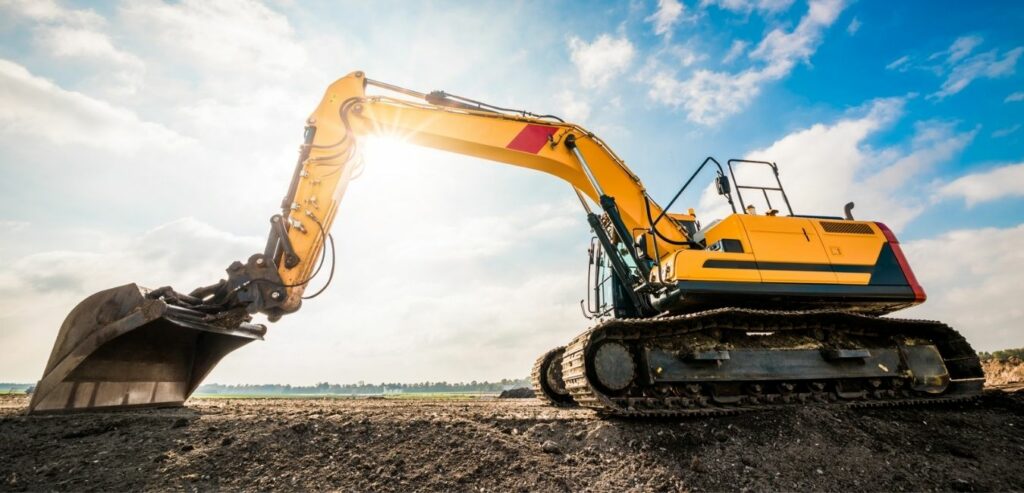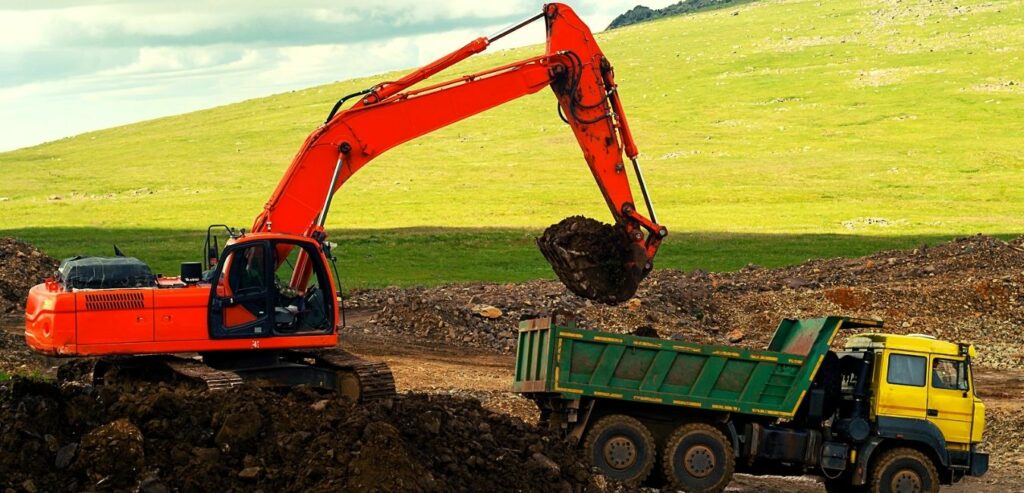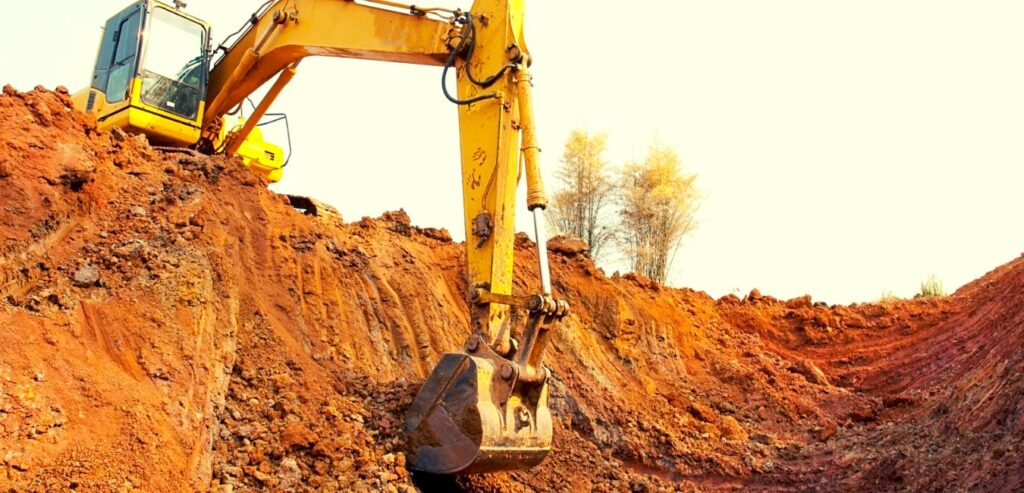Whether you plan to erect a commercial or residential site, excavation work is essential to guarantee a reliable foundation.
Every construction site has unique characteristics, but the site needs preparation for the foundation. Therefore, excavation is among the most critical construction processes, as it determines the suitability of a foundation in a project.
This article provides information on the various pre-construction excavation works, their importance, and how much they cost.
Table of Contents
What is Land Excavation?
Land excavation is more than digging holes in the ground. It is the process of removing soil from a workplace to form a trench, cavity, or tunnel. Land excavation involves heavy machinery like bulldozers, excavators, backhoes, and forward loaders.
Though excavation is typically used in construction to grade and lay foundations, it can be multi-purposed as it can involve tunneling, creating wall shafts, and earthworks.
Excavation is essential for all projects as it creates a strong foundation for a construction project. Only experienced engineers and contractors can determine the excavation work necessary for a project.
Why Excavate land?
Excavation is vital in determining the capability of a structure to withstand stress. It helps link the distinct features in a project. Clearing the site of unwanted boulders and rocks and moving the earth makes further work possible.
The excavation also helps in trenching for building septic tanks and channels for drainage pipes, which is vital for any construction project.
How is Excavation Priced?
Excavation is priced as per the volume in cubic yards of dirt removed. Small projects cost less than big ones, and the cost is higher for projects with difficult-to-reach areas than for easily accessible projects. A small job can cost $100 an hour, while big jobs cost over $500.
The equipment used in an excavation job affects pricing, as excavation machinery is expensive to maintain.
The time of the year also influences excavation costs. There are some periods when contractors are off-season, and they are likely to offer lower prices, especially during early Spring or late Fall. However, it would be best to confirm whether the outdoor temperatures affect your construction work before hiring.
The soil type in your area affects excavation costs. Soft ground is easier to excavate than hard and stony ground, which will cost more. The project’s location also affects total costs. The farther away from the excavation company, the higher the excavation costs.As you can see, several factors affect the pricing of excavation works, and it is best to work with a licensed cost estimator to get a fair quote.

Average Excavator Hourly Rate
A typical excavation job costs anywhere between $40 to $150 an hour. However, finding contractors willing to work at an hourly rate might be challenging, as most prefer quoting per cubic yard or an entire project.
Residential projects cost between $50 to $200 per cubic yard, and the total cost of excavation in a residential project can run between $1445 and $5430.
The hourly rate depends on the project’s layout, geographical location, and challenges present in the job.

Land Excavation Costs
There are different cost factors included in land excavation costs. Below are the main expenses incurred during land excavation.
Grading
One of the high land excavation costs is grading. Grading helps adjust the slope and soil elevation in a construction site before beginning construction. It is necessary before excavation, as it helps remove earthen materials to create an even surface and help create a solid foundation.
The average grading cost is $500 to $1000 for small yards but significantly varies with site conditions. It costs an average of $1000 to $5000 to grade a home lot or an average backyard.
Like excavation, grading uses heavy equipment, and certified civil engineers prepare a comprehensive grading plan. Most municipalities have by-laws that require homeowners to have licenses and a detailed grading plan before starting the work.
Areas with unique environmental considerations like seismic activities and wetlands also significantly affect grading and land excavation costs. Additional factors like neighboring properties, drainage requirements, and underground utilities also affect grading costs.
Though engineers understand design standards, it is best to refer to municipal land development laws to determine how they interact with existing works.
Site cut and fill
A site’s cut-and-fill targets are minimizing waste reduction as much as possible. A project with more cut than fill forces the project managers to find somewhere to dump the excess wastes, and a project with more fill than cut forces the project managers to bring dirt from another location.
Additional cut and fill increases material, labor, and equipment costs. This additionally influences overall excavation costs. It is necessary to plan how to keep the cut and fill at approximately equal volumes to minimize the need to cut or fill the excess mass.
Though it effectively conserves landmass, cut and fill is expensive, and the costs increase as more land moves. To help maximize the efficiency of the process, site planners utilize a cut-and-fill map.
Though cut and fill utilize the existing terrain, detailed planning is necessary to smooth the process. Project planners need detailed survey information and software to help them process data in a meaningful manner.
Cut and fill maps illustrate areas where cut and fill is necessary. These maps have exact measurements of elevation and topography. These maps are generated from precise measurements of the existing elevation and topography.
After determining the cut and fill necessary in your project, you need to plan out your labor and construction costs. Various software is available for generating cut and fill maps and automatically optimizing excavation costs.
Land leveling
Land leveling is flattening and smoothening a site’s surface before construction starts. Leveling is also used to correct drainage issues and prevent soil erosion. It requires special equipment and is costlier if the land is enormous.
Land leveling costs vary with the type of project. Concrete patios and driveways cost anywhere between $1000 and $2500. Leveling for foundations for new constructions can cost anywhere between $1500 to $6000.
The labor costs go up if you are leveling a site with many rocks and trees. This is because the contractor has to bring in more equipment and work longer. Additional fees may apply for topsoil landscaping and grading.
Re-sloping to improve drainage and erosion control also makes the land leveling work take more time, increasing the final costs. Some projects, especially huge ones, need special permits for land leveling, which can drive up overall costs. Consult your contractor for more information.

Terrain
Several processes are involved in the excavation. These include trenching, digging, dredging, and site development. Steep terrain and rugged ground conditions limit the accessibility of the weight and equipment that can be used on-site.
Terrain with hard rocks or cold winter areas is also hard on machinery, slowing down any construction activity. They also increase wear on the machinery, thus driving up construction costs.
In areas with very loose soils, it isn’t easy to protect the strength of the slopes after excavation. Protecting the slopes needs specialized techniques and equipment and costs more.
Machinery and Equipment
So much is at stake in a construction project, and having the right tools determines your project’s success rate. There are different kinds of excavation jobs, such as lifting and moving, compacting and grading, or loosening rock.
All these excavation jobs require specialized equipment. Before deciding on excavation equipment, you need to consider the nature of your construction site. The terrain, obstacles, hazards present, and need for dredging affect the type of equipment you need.
The comfort and skill of machine operators also determine the quality of work, and you, therefore, need skilled operators to get better results in your project.
Backhoe loaders are used for shoveling and moving dirt in small and medium-sized jobs. You might need a bulldozer to push piles of dirt for big jobs. The excavator is also used for big jobs, and it has a big arm attached and is used for demolition, digging trenches, and lifting heavy objects.
Other excavation equipment includes trenchers, skid-steer loaders, spider excavators, and zero-swing excavators. Your excavation equipment should always have the essential features and attachments to complete the job.
Other Factors to Consider
Other factors affecting costs that you need to consider before excavation include; training and education of workers, emergency and rescue procedures, planning for adverse weather conditions, and potential hazards affecting soil stability.
Identify all power and overhead lines and all legislative requirements affecting your jurisdiction and the protective measures to be taken as they impact overall costs. Temporary protective structures such as trench boxes also drive up overall costs. Areas with monolithic ground that may require some blasting need special considerations during excavation.
How to calculate excavation costs
To calculate excavation costs, multiply the excavated zone’s length, width, and depth to estimate its volume. To obtain the cost of excavation, multiply the total excavation volume by the price of the area per unit.
If an excavated area has a length of 12m and a width of 5m, and a height of 5m
In the formula,
Volume= L*W*H
12m *5m *5=300m2
If the price per unit is $8, then the total price will be;
Total price= 300*8=$2400.
Breakdown of Excavation Costs
On average, excavation costs range between $1473-$5793 per cubic yard. The costs are dependent on the size and difficulty of the job. The deeper the excavation is done, the more expensive the job will be.
Below is a breakdown of the average price of the entire excavation process;
| Excavation Process | Average Price |
| Land clearing | $200 -$6,500 |
| Site excavation | $50 -$200 per cubic yard |
| Land leveling | $50 -$165 per hour |
| Dirt removal | $7 -$25 per cubic yard |
| Cut & fill | $3 -$16 pet cubic yard |
| Trenching | $450 -$1,300 |
| Machinery | $150 -$ 230 per job |
| Labor | $50 -$250 per cubic yard |
What is Included in excavation?
Excavation is extracting and moving soil and rock to form a space for the construction. The type of excavation affects the cost; the deeper you dig into the soil, the more expensive the type of equipment. Land excavation happens from the topmost soil in a process called topsoil excavation up to the bottom layer of soil in a process called basement excavation.
Earth excavation is removing the layer immediately after the topsoil, while rock excavation includes drilling of rock and large boulders to move them away from the project area.
Muck excavation is when the combining layer of soil and water is dug from the ground and then spread out to dry or moved while dredging creates a pump that removes sediment buildup from the bottom of the bank. In trenching, the length of the excavated site surpasses the depth to create a foundation for the sewer system, built-in pipelines, and even hide service lines.
FAQs
How much does an excavator cost?
The price of an excavator differs based on; its size, model, features, performance, and the brand you prefer most. Typically, an excavator costs between $100,000 to $850,000.
What is an excavation plan?
An excavation plan is a document given before the start of a project to outline the vertical and horizontal boundaries of the excavation to be done. Having an excavation plan ensures that health and safety are present from the start to finish of the project. This is key to the progression of the project. Every excavation project should have well-detailed information on the location, machinery, site management, and standard precautions.
How much can an excavator dig per day?
Excavators differ depending on the type of excavation done, their bucket capacity, and the skill of the machine operator. An excavator can dig from 350-1000 cubic yards in a day.
Summary
As you can see, there are numerous factors affecting excavation costs. Construction excavation needs skill, experience, and expertise, affecting the entire project’s foundation.
It is best to work with engineers and licensed contractors to help you get the best out of your project. A contractor that values safety and is known for quality work enables you to achieve the best in your project.

